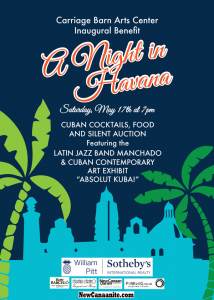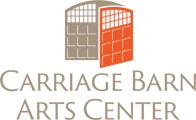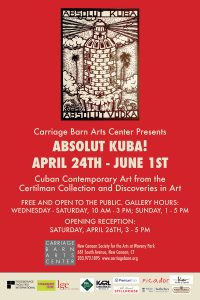Carriage Barn Arts Center Showcases Works by Cuban Artists
Absolut Kuba! Exhibition Opens on April 24, Inaugural Benefit Set for May 17
NEW CANAAN, Conn. (March 31, 2014) – The Carriage Barn Arts Center is pleased to present Absolut Kuba!, an upcoming exhibition featuring works by emerging and established Cuban artists. The show opens on Thursday, April 24 and highlights pieces from the private collection of Greenwich, Connecticut residents, Terri and Steven Certilman. The exhibition opening reception, which is open to the public, will be held on Saturday, April 26 from 3pm to 5pm. Absolut Kuba! will be on view through June 1, 2014.
Absolut Kuba! showcases a significant collection of contemporary Cuban art that the Certilmans have acquired over more than a decade. Through their online gallery, Discoveries in Art, LLC, the couple sources pieces directly from the artists during travels to Cuba and the duo is dedicated to promoting the country’s artistic talent. Steven Certilman offers the following insight into the Cuban art world – “the unique political, social and economic conditions in Cuba have combined to catalyze what may be the world’s highest concentration of artistic talent. Their works are as diverse as the country’s rich cultural heritage. It is said that the eyes are the windows of the soul. Art is the window to the Cuban soul.”
The painting and sculpture in the show, curated by Certilman and Carriage Barn Arts Center Co-director Arianne Faber Kolb, explores Cuban identity and its diverse cultural heritage, the political climate and its backdrop of geographical isolation and emigration. The works are expressions of the soul, beauty, and fortitude of the Cuban people, and how they meet and overcome the circumstances imposed upon their lives. “This exhibition presents an exciting and unique opportunity for the Carriage Barn Arts Center to highlight and promote the work of highly talented Cuban artists and to educate the community about what it means to be Cuban on multiple levels,” says Kolb.” With this in mind, we are hosting the exhibiting artist Héctor Frank, who is traveling from Havana to the US for the first time to attend the opening,” she continued.
 In conjunction with Absolut Kuba!, the Carriage Barn Arts Center will host its inaugural benefit, A Night in Havana. The gala will take place on Saturday, May 17 and features Cuban food, cocktails, a silent auction and music by Manchado, an Afro-Cuban Jazz band comprised of local musicians that have played with the Allman Brothers, John Scofield, Deep Banana Blackout and Martin Sexton. Event tickets are currently available for purchase online at carriagebarn.org. Guests can choose between two levels of support: $150 for the individual level and $300 for the patron level. The patron level includes admission to the May 17 gala as well as an invitation to join artists, collectors and event sponsors for an exclusive exhibition preview reception on Wednesday, April 23. For more information, visit www.carriagebarn.org or call the Center directly at 203.972.1895.
In conjunction with Absolut Kuba!, the Carriage Barn Arts Center will host its inaugural benefit, A Night in Havana. The gala will take place on Saturday, May 17 and features Cuban food, cocktails, a silent auction and music by Manchado, an Afro-Cuban Jazz band comprised of local musicians that have played with the Allman Brothers, John Scofield, Deep Banana Blackout and Martin Sexton. Event tickets are currently available for purchase online at carriagebarn.org. Guests can choose between two levels of support: $150 for the individual level and $300 for the patron level. The patron level includes admission to the May 17 gala as well as an invitation to join artists, collectors and event sponsors for an exclusive exhibition preview reception on Wednesday, April 23. For more information, visit www.carriagebarn.org or call the Center directly at 203.972.1895.
The Carriage Barn Arts Center announces its event sponsors including Ferrari-Carano; FitWell Group; Foodservice Facilities International; HTG Investment Advisors, Inc.; LGE Fine Art Consulting; Moffly Media; NewCanaanite.com; Picador Restaurant; Premium Park; Ron Barceló; Strawberry and Sage; The Karl Chevrolet Company; Van Brunt Stillhouse; Vista Wine & Spirits; Weed & Duryea and William Pitt Sotheby’s International Realty.
The Carriage Barn Arts Center, home of the New Canaan Society of the Arts, is a 501(c) (3) non-profit arts organization that offers artists the opportunity to exhibit their work in an exceptional gallery space, a unique nineteenth-century stone barn. Exhibitions, lectures, educational workshops, concerts and other events are held in this adaptively reused historical building on the grounds of a former estate, now Waveny Park. Gallery hours: Wednesday – Saturday (10am – 3pm); Sunday (1pm to 5pm); July, August (by appointment).
###
Absolut Kuba! Featured Artists
Abel Barroso Arencibia (b. 1971) creates handcrafted wooden sculptures that represent the Cuban search for identity and emphasize the challenges in accessing new technologies. Barroso has exhibited at the Tate Gallery in London and the Marlborough Gallery in New York, and his work is in the collections of the Museum of Modern Art and the Whitney Museum.
The moving and spiritual work of Juan Roberto Diago Durruthy (b. 1971) draws on elements of his Afro-Cuban religion in treating race, religion and slavery. His work has been featured in major galleries worldwide, including the Marlborough Gallery in New York.
Roberto Fabelo (b. 1951) is one of Cuba’s finest artists. A master of drawing, painting, watercolor, engraving and installation, Fabelo uses portraits, grotesque figures and scenery to create works which blur the line between fantasy and reality. In 2004, he was awarded the Premio Nacional de Artes Plásticas, Cuba’s top award in fine arts.
Héctor Frank Heredia García (b. 1961) creates works primarily in an abstract or abstract figurative style. The pieces have evolved over time from works on paper, to canvas and currently repurposed wood. The artist often uses pieces of old doors or furnishings as the foundation for his projects on wood, employing other found materials to accent the paint and bring the character to life by lifting it off the background.
Carlos Guzmán Hernández (b. 1970) possesses a unique post-medieval style that combines fantasy and allegory. He brings his audience to a real world where people do not go. A parallel universe perhaps. His androgynous subjects adorned in richly decorated costumes reflect an era lost in the passage of time yet they tell a story as real in that lost era as it is today.
Manuel Mendive Hoyo’s (b. 1944) prolific work crosses many media. He uses drawing, painting, body painting, wood carving, bronze sculpture, and performance that integrates loosely choreographed dance with rhythmic music. The primary theme in his art is his recognition that African religion and African culture have shaped Cuban national identity and culture.
The Brito Jorge sisters, Jacqueline (b. 1973) and Yamily (b. 1972), both instructors at Cuba’s most distinguished art academy, Istituto Superior de Arte, make different but equally strong statements about their culture. Jacqueline’s work is rich in the symbolism of nature as it speaks to the political climate. Yamilys’ work deals with diverse topics, such as culture, spirituality, history, and geographic isolation.
Harold López Muñoz (b. 1977) seeks to create an atmosphere of constant uncertainty, transmitting states of mind rather than easily identifiable events, ignoring the superfluous details and descriptions of detailed environments so that the viewers complete, from their own experience, the interpretation of the scenes that he proposes.
Manuel López Oliva (b. 1947) is both an award-winning artist and an accomplished art critic. Among many national honors, he holds the Award for Distinction in National Culture and an Honorary Degree for Artistic Merit from the Instituto Superior de Arte where he serves as a Consulting Professor. He has also received the Guy Pérez Cisneros National Prize for lifetime achievement in the field of art and cultural criticism.
William Pérez (b. 1965) is a highly acclaimed artist, who has had shows in Germany, Denmark, and Mexico. He sees himself as a creator who is constantly re-inventing himself through his development of new techniques. He strives to evolve and grow as an artist and as a conscientious contributor to society.
Ibrahim Miranda Ramos’ (b. 1969) obsession with maps reflects his conscious desire to revise the map of Cuba. He creates his biomorphic landscapes on the surface of these maps almost completely obliterating any trace of the landmass below. He gives us small glimpses of the original surface, as if he is in the process of sculpting a new world over the old Cuba.
Sandra Ramos (b. 1969), one of the most important contemporary Cuban artists, is represented in the collections of the Museum of Fine Arts in Boston and other international museums. Ramos represents the relationship between personal and political. She deals with the painful experiences of living in and breaking away from Cuba, migration and the separation of families.
Angel Ramírez Roque (b. 1954) uses sarcasm and humor to describe life in Cuba. His art is recognizable by its clear and precise iconoclastic sagacity. He uses recycled objects, text and images, many taken from medieval times. Splendid images, sometimes accompanied by text or words bring to the fore his talent, intelligence, sense of humor and use of sarcasm which all work together to produce the visual poetry that defines his work.
The work of Eduardo Miguel Abela Torrás (b. 1963) is a satirical reflection of the Cuban phenomenon. He often makes connections between the situation in Cuba and other countries in Latin America and beyond. The themes he addresses include the loss of values, corruption, economic crisis, exodus, and the division of the family.

